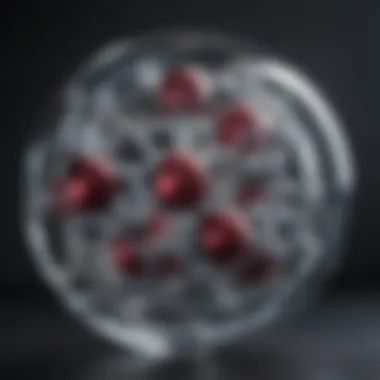Lumakras vs Chemotherapy: A New Era in Cancer Treatment


Intro
The evolution of cancer treatment has branched into several paths over the years, each adjusting to the needs of patients and the complexities of cancer itself. Among these advancements stands Lumakras, a medication that caters to specific mutations within cancer cells, particularly in non-small cell lung cancer. This article will navigate through Lumakras and its distinction from traditional chemotherapy, providing insights that illuminate the unique role Lumakras plays in oncology today.
Article Overview
Purpose of the Article
The primary aim of this article is to offer a comprehensive examination of Lumakras, providing a clear contrast to the established chemotherapy approaches. Both the pharmacodynamics and the clinical applications of Lumakras are scrutinized to highlight their differences and implications on patient care.
Relevance to Multiple Disciplines
Understanding Lumakras and its functionality is vital not only for oncologists but also for researchers and medical professionals involved in cancer treatment. The study's insights are beneficial in medical education, research frameworks, and ultimately patient care frameworks across various healthcare settings.
Research Background
Historical Context
Chemotherapy has for decades served as a staple in cancer treatment, employing cytotoxic drugs to eliminate rapidly dividing cells. However, these treatments often come with a plethora of side effects and provide variable efficacy depending on individual patient biology. Lumakras marks a shift toward precision medicine, targeting specific genetic aberrations, notably the KRAS G12C mutation. Such mutations were historically considered undruggable; thus, Lumakras symbolizes a breakthrough in cancer therapeutics.
Key Concepts and Definitions
- Lumakras: A targeted therapy composed of the active ingredient sotorasib.
- KRAS G12C Mutation: A genetic alteration in cancer cells, making them reliant on the KRAS protein for growth.
- Cytotoxicity: The quality of being toxic to cells, a key characteristic of conventional chemotherapy agents.
- Precision Medicine: An approach that customizes treatment based on individual patient profiles and specific tumor characteristics.
In summary, Lumakras represents a pivotal moment in oncology, offering tailored treatment compared to the broad-spectrum effects of traditional chemotherapy. The next sections will delve deeper into the mechanisms of Lumakras and how it interfaces with standard methodologies in cancer treatment.
Understanding Lumakras
The significance of comprehending Lumakras lies in its potential to transform cancer treatment. Lumakras, as a targeted therapy, offers a more personalized approach compared to conventional chemotherapy. It specifically inhibits the KRAS G12C mutation, a prevalent target in various cancers, which can lead to better outcomes for patients. As cancer treatment evolves, understanding these distinctions becomes crucial for healthcare professionals and researchers alike.
Targeted therapies, like Lumakras, represent a paradigm shift. Unlike traditional therapies that often affect all rapidly dividing cells, targeted treatments act on specific molecular targets. This specificity can lead to enhanced efficacy and possibly less harm to healthy cells.
With the rise of precision medicine, grasping the fundamentals of Lumakras is essential. This understanding allows for more informed discussions about treatment options, guiding selection criteria for patients who may benefit from this therapy, and potentially leading to improved patient outcomes. Furthermore, as research into Lumakras progresses, insights gained can further refine its role in oncology, paving the way for new avenues of investigation.
Definition of Lumakras
Lumakras, generically known as sotorasib, is a small molecule therapeutic agent that targets the mutated form of the KRAS protein, specifically the KRAS G12C variant. This mutation is noted for its involvement in the development of numerous tumors, particularly non-small cell lung cancer (NSCLC). By effectively inhibiting KRAS G12C, Lumakras aims to halt tumor growth and induce cancer cell death.
Without this targeted intervention, individuals harboring the KRAS G12C mutation often face limited treatment options, as traditional chemotherapies frequently yield suboptimal results. Lumakras has shown promise as a viable alternative, marking a significant advancement in the treatment of cancers associated with this mutation.
Mechanism of Action
The mechanism of action of Lumakras is centered around its ability to bind to the KRAS G12C protein. This binding results in the inhibition of downstream signaling pathways, which are crucial for cell proliferation and survival. Specifically, Lumakras locks the KRAS protein in an inactive state, preventing the progression of cellular signalling that leads to tumorigenesis.
Studies suggest that by disrupting these pathways, Lumakras can initiate cellular apoptosis in tumors expressing the KRAS G12C mutation. Moreover, this specificity means patients with this mutation may experience a more targeted effect of the drug, potentially leading to better treatment outcomes.
Lumakras enables oncologists to move away from the one-size-fits-all approach, focusing instead on genetic profiles to tailor cancer treatment.


Lumakras enables oncologists to move away from the one-size-fits-all approach, focusing instead on genetic profiles to tailor cancer treatment.
Chemotherapy Overview
Chemotherapy plays a central role in the treatment of various cancer types. It refers to the use of drugs to kill cancer cells, primarily targeting cells that divide quickly. This process is crucial in conventional oncology, as it has been the cornerstone of treatment for decades. Understanding chemotherapy is vital for comparing it with newer therapies like Lumakras. Familiarity with chemotherapy’s principles illuminates the advantages and limitations faced by patients and healthcare professionals.
Definitions and Classifications
Chemotherapy can be defined as a systemic treatment method that employs cytotoxic drugs to impair or destroy cancer cells. These drugs are classified based on their action mechanisms, toxicities, and cancer targets. Common classifications of chemotherapy drugs include:
- Alkylating Agents: They work by damaging DNA, preventing cancer cells from dividing. Examples include Cyclophosphamide and Ifosfamide.
- Antimetabolites: These mimic natural substances within the cell. When incorporated into the cellular metabolism, they disrupt essential processes. Methotrexate is a notable antimetabolite.
- Antitumor Antibiotics: These come from natural sources and act by inhibiting DNA and RNA synthesis. Doxorubicin is widely known in this category.
- Mitotic Inhibitors: These drugs block cell division by interfering with the mitotic spindle. Paclitaxel is a classic example.
Proper categorization helps in understanding the specific applications of these drugs in treating various cancers, allowing for more effective treatment planning.
Mechanisms of Chemotherapy Drugs
The mechanisms by which chemotherapy drugs operate are diverse, which adds to the complexity of cancer treatment. Here are some primary mechanisms:
- DNA Damage: Alkylating agents directly damage the DNA strands, hindering replication and leading to cellular death. This effect is particularly potent in rapidly dividing tumors.
- Inhibition of Metabolism: Antimetabolites disrupt critical metabolic pathways by impersonating vital cellular components, thus leading to halted growth of cancerous cells.
- Interference with Cell Division: Mitotic inhibitors target the mitosis phase of the cell cycle, preventing successful cell division and contributing to cancer cell depletion.
- Blockage of DNA/RNA Synthesis: Antitumor antibiotics disrupt the fundamental processes of transcription and replication, leading to cellular dysfunction and death.
Chemotherapy's diverse mechanisms allow it to target various aspects of cancer cell biology, yet this systemic approach often comes with significant side effects due to the impact on normal, healthy cells. This aspect contrasts notably with targeted therapies such as Lumakras, which focus specifically on altering mutations present in cancer cells without broadly affecting healthy tissue.
Comparative Analysis of Lumakras and Chemotherapy
The comparative analysis between Lumakras and chemotherapy is vital to understand the evolving landscape of cancer treatment. This section illuminates the distinctions in their operational frameworks, therapeutic efficacy, and patient experiences. Together, they offer a divergent approach in combating cancer.
By examining targeted therapy versus systemic treatment, the nuances of how these therapies interact with cancer cells become clearer. One must consider how Lumakras selectively inhibits specific pathways, in contrast to the broader mechanisms of traditional chemotherapy. This particularity shapes the potential outcomes and affects which patients are best suited for treatment. Understanding these distinctions enhances clinical decision-making and influences patient management strategies.
Targeted Therapy vs. Systemic Treatment
Lumakras functions as a targeted therapy, specifically designed to target mutations in the KRAS gene that drive certain cancers. This level of specificity tends to minimize damage to surrounding healthy tissues, which is often a significant concern in systemic treatments like chemotherapy. Unlike Lumakras, chemotherapy employs systemic treatment that targets rapidly dividing cells indiscriminately. As a result, chemotherapy may affect various cells throughout the body, resulting in broader side effects.
The advantages of targeted therapy include:
- Precision: Directly targets cancerous cells with minimal impact on normal cells.
- Reduced Side Effects: Results in fewer adverse reactions compared to systemic treatments.
- Focused Efficacy: May lead to more effective outcomes for particular cancer subtypes due to its specific targeting.
Conversely, the systemic approach in chemotherapy is characterized by its ability to:
- Attack a Range of Cell Types: It can be beneficial for multiple tumor types, not limited to specific mutations.
- Comprehensive Treatment: Useful as an adjunct in combination therapies to enhance outcomes.
Efficacy in Specific Cancer Types
Efficacy is one of the most crucial metrics when evaluating cancer treatments. Lumakras has shown promising results, particularly in patients with non-small cell lung cancer harboring the KRAS G12C mutation. Trials indicate that Lumakras may lead to considerable tumor reduction and improved overall survival rates.
Chemotherapy, on the other hand, maintains relevance in various cancer types, such as breast and colorectal cancer. The role of chemotherapy might be more beneficial in certain contexts, especially in advanced-stage cancers where rapid response is necessary. However, it might not display the same level of targeted efficacy seen with Lumakras in the context of precision medicine.
Patients often respond differently based on their cancer’s genetic landscape. Thus, understanding the type of cancer being treated becomes pivotal in determining an effective strategy.


Side Effects Comparison
Side effects present another critical area for consideration when comparing Lumakras and chemotherapy. Patients undergoing chemotherapy frequently report a range of adverse effects, including nausea, fatigue, hair loss, and increased susceptibility to infections. These side effects arise from the drug attacking not only cancer cells but also healthy cells that regenerate quickly.
In contrast, patients using Lumakras generally experience milder side effects, which often include:
- Fatigue
- Diarrhea
- Liver enzyme elevation
"Knowing the side effect profiles helps patients prepare for treatment experiences."
"Knowing the side effect profiles helps patients prepare for treatment experiences."
By understanding these parameters, healthcare providers can better inform patients and guide them towards an appropriate choice that aligns with their health needs and preferences.
In summary, analyzing the comparative merits of Lumakras and chemotherapy emphasizes the evolution of cancer therapies. The distinct characteristics, efficacy, and side effects play pivotal roles in defining patient treatment pathways. The ongoing research continues to shape our understanding of these differences, marking a significant shift towards personalized medicine.
Clinical Implications of Lumakras
The clinical implications of Lumakras are significant in the context of modern cancer treatment. Understanding these implications allows healthcare professionals to make informed decisions regarding patient management and therapeutic strategies. Lumakras represents a shift towards personalized medicine. This approach is particularly relevant for patients with specific genetic profiles, allowing for tailored therapies that could enhance treatment efficacy.
FDA Approval and Indications
Lumakras, also known as sotorasib, received approval from the FDA in May 2021. This approval was specifically for adult patients with non-small cell lung cancer (NSCLC) harboring the KRAS G12C mutation who have received at least one prior systemic therapy. The significance of this indication is noteworthy. It highlights the role of targeted therapies in treating cancers with known genetic alterations.
The approval also underscores the urgency for alternative treatment options that can potentially improve survival rates.
“Lumakras marks a significant milestone in oncology as the first targeted therapy aimed specifically at the KRAS mutation.”
“Lumakras marks a significant milestone in oncology as the first targeted therapy aimed specifically at the KRAS mutation.”
In clinical settings, doctors are now equipped to prescribe Lumakras for patients whose tumors exhibit this specific mutation. This targeted approach can lead to better outcomes compared to traditional therapies, which often do not account for individual genetic markers.
Patient Selection Criteria
Selecting the right patients for Lumakras therapy involves several key criteria. Physicians must confirm the presence of the KRAS G12C mutation, which is crucial for the drug's effectiveness. This is done through biomarker testing, a process where tumor samples are analyzed to identify specific genetic changes. Without this mutation, Lumakras is unlikely to provide benefits.
Additionally, patient history and previous cancer treatments are considered. Extensive prior treatments may impact a patient's candidacy for Lumakras. It is also vital to evaluate the patient's overall health and comorbid conditions.
Factors influencing patient selection may include:
- Age and general health status
- Previous treatment responses
- The presence of progressive disease
Current Research and Developments
The section of Current Research and Developments is crucial because it helps to understand how Lumakras is evolving in cancer treatment. Ongoing studies and recent discoveries shed light on its mechanism, efficacy, and potential future applications. New insights regarding Lumakras can improve treatment protocols, guiding clinicians in the selection of personalized therapies. As research continues, it may address pressing questions about long-term effects and overall effectiveness against various cancers.
Ongoing Clinical Trials


Ongoing clinical trials are essential to validate the effectiveness of Lumakras. Currently, several trials focus on the drug's use in different cancer types. The trials explore its impact on patients with KRAS G12C mutations, which are prevalent in lung and colorectal cancers.
These clinical trials assess:
- Efficacy: Investigating how well Lumakras reduces tumor size compared to standard chemotherapy.
- Dosage: Determining optimal dosing that maximizes benefit while minimizing side effects.
- Combination therapies: Exploring effects of combining Lumakras with other targeted therapies or immunotherapies.
Patients enrolling in these studies gain access to cutting-edge treatments while contributing to finding valid solutions for cancer management. Each study is crucial for the comprehensive understanding needed in making definitive recommendations for future clinical practice.
Recent Findings and Outcomes
Recent findings from clinical trials have provided promising data regarding Lumakras. Initial studies indicate that patients respond favorably to treatment, with significant tumor shrinkage reported in many cases. Importantly, some outcomes include:
- Increased progression-free survival compared to chemotherapy, which usually has a broad range of side effects.
- Notable reduction of adverse events linked with traditional chemotherapy, allowing for better patient quality of life.
"The tolerability and effectiveness of Lumakras suggest a shift towards more personalized cancer care strategies."
"The tolerability and effectiveness of Lumakras suggest a shift towards more personalized cancer care strategies."
Continued examination of patient outcomes will be vital. Data from these findings will shape future treatment protocols, ensuring that patients receive tailored and effective cancer therapies.
Future Perspectives in Cancer Treatment
Future perspectives in cancer treatment represent a significant area of exploration. As the landscape of oncology evolves, the integration of innovative therapies like Lumakras is essential. This section focuses on the potential developments, the transformational impacts on patient care, and the future of therapeutic strategies against cancer.
Emerging Therapies
The field of oncology is witnessing the emergence of therapies that go beyond traditional methodologies. Lumakras serves as a leading example, shifting the focus from broad treatment to targeted interventions.
Several key aspects denote the importance of emerging therapies:
- Precision Medicine: Therapies tailored to a patient’s specific genetic makeup, such as Lumakras for KRAS mutations, exemplify how cancer treatment is moving toward more individualized approaches.
- Combination Therapies: New treatments may work more effectively in synergy with existing drugs. For instance, combining Lumakras with immunotherapies could enhance outcomes for patients who do not respond to single-agent treatments.
- Advanced Delivery Mechanisms: Developing methods for effective drug delivery, such as nanoparticles or oncolytic viruses, enhances bioavailability and minimizes damage to healthy tissues.
The exploration of these therapies not only opens potential new avenues for existing patients but also expands the horizons for future cancer treatments, aiming to overcome resistance commonly seen with chemotherapy.
Long-Term Implications for Patients
Understanding the long-term implications of emerging therapies is vital for patients, healthcare providers, and stakeholders in the medical community.
- Survival Outcomes: The long-term survival rates for patients receiving targeted therapy like Lumakras show promise. Studies indicate that patients with advanced cancers can experience improved progression-free survival compared to traditional treatments.
- Quality of Life: Targeted therapies tend to have more manageable side effects than conventional chemotherapy. Patients on Lumakras often report better overall quality of life, given the avoidance of toxic effects common with broader-spectrum chemicals used in chemotherapy.
- Healthcare Costs: While the upfront costs of targeted therapies may be significant, the potential for reduced hospitalizations and lower long-term treatment costs requires consideration. The focus on effective, long-term results can lead to overall cost savings in cancer care.
The advancement of precision oncology signals a shift in how cancer is treated, potentially leading to better patient outcomes and efficiency in healthcare delivery.
The advancement of precision oncology signals a shift in how cancer is treated, potentially leading to better patient outcomes and efficiency in healthcare delivery.
Closure
In this article, the discussion around Lumakras and its distinctions from traditional chemotherapy showcases the evolving landscape of cancer treatment. Recognizing Lumakras as a targeted therapy emphasizes its role in precision medicine, offering a refined approach to treating certain types of cancer.
Summary of Key Points
The key findings from this article include:
- Definition and Mechanism: Lumakras is specifically designed to target KRAS G12C mutations, differentiating its action from the broader, systemic approach of chemotherapy.
- Clinical Implications: The FDA approval of Lumakras highlights its significance in treating advanced non-small cell lung cancer with specific genetic markers. This paves the way for personalized treatment plans.
- Comparative Analysis: Compared to chemotherapy, which often affects rapidly dividing cells indiscriminately, Lumakras focuses on cancer cells, potentially reducing side effects.
- Future Perspectives: Ongoing research and developments indicate a need for further exploration into its long-term implications and effectiveness in various patient populations.
In summary, Lumakras represents a pivotal advancement in cancer therapy. Its distinction from chemotherapy not only indicates a move toward targeted therapies but also opens new avenues for clinical research and treatment methodologies. As the field continues to evolve, understanding these nuances remains critical for patients and healthcare professionals alike.



